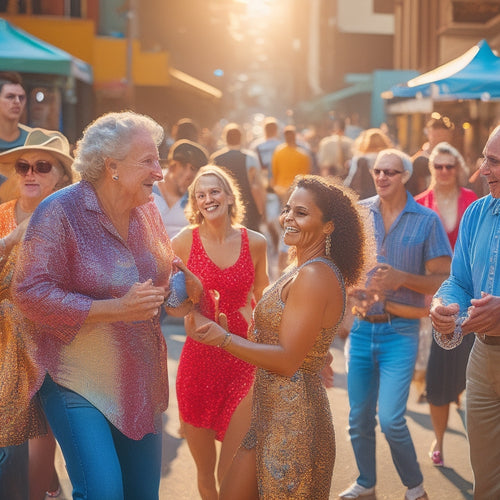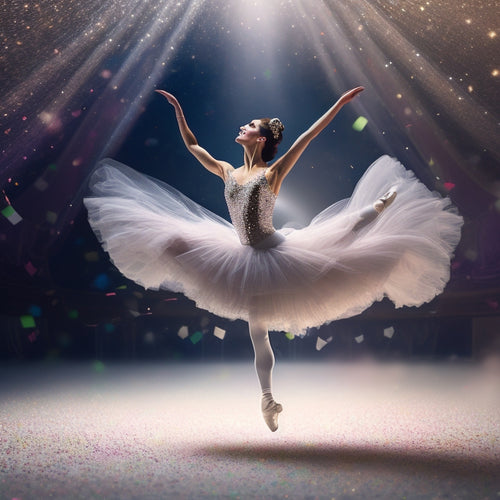
Innovative Dance Installation Blends Motion Tracking Tech
Share
We're witnessing a fusion of dance and motion tracking technology, where Kinect sensors capture subtle movements, and data translation enables immersive installations. Collaborations between artists, engineers, and performers push interactive art boundaries, merging diverse skill sets to create remarkable synergies. As we explore this convergence, we're discovering new ways to engage audiences, from interactive storytelling to volumetric light spheres that captivate viewers. With real-time processing and 3D mapping, dynamic environments emerge, and we're just scratching the surface of what's possible when dance meets motion tracking tech - there's more to uncover in this innovative fusion.
Key Takeaways
• Motion tracking technology like Kinect sensors captures precise dance movements, enabling immersive and interactive dance installations.
• Collaboration between artists, engineers, and performers pushes interactive art boundaries, merging diverse skill sets in innovative projects.
• Integration of motion tracking technology with audiovisual elements creates immersive experiences, engaging audiences through emotional connection and storytelling.
• Real-time processing and 3D mapping generate dynamic environments, captivating viewers with volumetric light spheres and interactive elements.
• High-fidelity tracking capabilities of Kinect sensors capture human movement subtleties, enabling rich datasets to drive interactive experiences in dance installations.
Motion Tracking in Dance
By leveraging motion tracking technology, such as Kinect sensors, we can accurately capture and translate the nuances of dance movements into digital data, enabling the creation of immersive and interactive dance installations.
This allows us to break down complex movements into precise, quantifiable data, which can be used to generate stunning visual effects, interactive light installations, or even influence audio elements in real-time.
The Kinect sensor's high-fidelity tracking capabilities enable us to capture the subtleties of human movement, creating a rich dataset that can be used to drive interactive experiences.
Creative Tech Collaborations
As we harness the power of motion tracking in dance, we're compelled to explore the collaborative potential of creative tech collaborations, where artists, engineers, and performers converge to push the boundaries of interactive art.
Through collaborative projects, we're able to merge diverse skill sets, fostering innovative approaches to art and technology. Our audiovisual partnerships have led to remarkable synergies, as seen in our work with Cinedans and Beamlab for VR jam events.
These partnerships allow us to integrate motion tracking technology with audiovisual elements, creating immersive experiences that redefine the intersection of dance and technology. By merging creative perspectives, we're able to craft innovative installations that captivate and inspire.
Immersive Performance Art
Through the fusion of motion tracking technology with audiovisual elements, we craft immersive performance art experiences that transport audiences into dynamic, interactive environments.
| Interactive Elements | Immersive Techniques | Audience Engagement |
|---|---|---|
| Motion tracking | Volumetric light spheres | Audience participation |
| Audio oscillators | Particle systems | Emotional connection |
| Sensor technology | Visual treatment | Interactive storytelling |
| Real-time processing | 3D mapping | Dynamic environments |
Frequently Asked Questions
What Software Is Commonly Used for Creating Interactive Motion-Tracked Dance Installations?
We often rely on TouchDesigner for creating interactive motion-tracked dance installations, but we also explore other tools like Motionbuilder for 3D animation integration and Isadora for real-time video effects and interactive processing.
How Do Motion Tracking Systems Enhance the Immersive Experience in Art Installations?
We utilize motion tracking systems to amplify immersive storytelling, fostering emotional resonance by precisely capturing performers' movements, and translating them into engaging visuals, thereby elevating the audience's emotional connection to the art installation.
Can Volumetric Light Spheres Be Used in Outdoor Installations?
We examine the feasibility of volumetric light spheres in outdoor installations, considering weather resistance and urban landscapes, to determine if they can withstand environmental factors and integrate seamlessly into public spaces.
What Is the Primary Function of the OSC Protocol in Interactive Experiences?
We overcome the objection that OSC is just for music by highlighting its primary function: enabling open-source, networked systems to seamlessly communicate, allowing us to focus on crafting immersive experiences that captivate our audience.
Are There Any Limitations to Using Kinect Sensors for Motion Tracking in Dance Performances?
We've found that Kinect sensors can be limited by sensor calibration issues, which affect accuracy, and data overload, leading to lag and latency, which can disrupt the fluidity of dance performances.
Related Posts
-

Get Stage-Ready: Online Dance Makeup Tutorials at Home
You're about to reveal the secrets to a stage-ready dance makeup look from the comfort of your own home. First, ident...
-

Sydney Street Dance Study Sparks Community Revival
In Sydney, a thriving street dance scene has revitalized the city's parks, streets, and studios, fostering a profound...
-

Instant Download Card for Dance Recital Performances
Instant download cards are a convenient way to commemorate dance recital performances, providing a seamless solution ...


